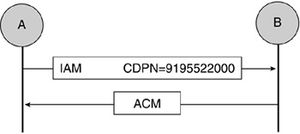Overlap
Contents |
Enbloc and Overlap Address Signaling
The Called Party Number (CdPN) is the primary key for routing a call through the network. When using ISUP to set up a call, the CdPN can be sent using either enbloc or overlap signaling. In North America, enbloc signaling is always used; in Europe, overlap signaling is quite common, although both methods are used.
Enbloc Signaling
The enbloc signaling method transmits the number as a complete entity in a single message. When using enbloc signaling, the complete number is sent in the IAM to set up a call. This is much more efficient than overlap signaling, which uses multiple messages to transport the number. Enbloc signaling is better suited for use where fixed-length dialing plans are used, such as in North America. The right diagram illustrates the use of enbloc signaling.
Overlap Signaling
Overlap signaling sends portions of the number in separate messages as digits are collected from the originator. Using overlap signaling, call setup can begin before all the digits have been collected. When using the overlap method, the IAM contains the first set of digits. The Subsequent Address Message (SAM) is used to transport the remaining digits. The bottom right diagram illustrates the use of overlap signaling. Local exchange A collects digits from the user as they are dialed. When enough digits have been collected to identify the next exchange, an IAM is sent to exchange B. When tandem exchange B has collected enough digits to identify the next exchange, it sends an IAM to exchange C; exchange C repeats this process. After the IAM is sent from exchange C to exchange D, the destination exchange is fully resolved. Exchange D receives SAMs containing the remaining digits needed to identify the individual subscriber line.
When using dialing plans that have variable length numbers, overlap signaling is preferable because it decreases post-dial delay. As shown in the preceding example, each succeeding call leg is set up as soon as enough digits have been collected to identify the next exchange.
Interdigit timing is performed as digits are collected from a subscriber line. When an exchange uses variable length dial plans with enbloc signaling, it must allow interdigit timing to expire before attempting to set up the call. The exchange cannot start routing after a specific number of digits have been collected because that number is variable. By using overlap signaling, the call is set up as far as possible, waiting only for the final digits the subscriber dials. Although overlap signaling is less efficient in terms of signaling bandwidth, in this situation it is more efficient in terms of call set-up time.
TelcoBridges and Overlap Signaling
TelcoBridges supports Overlap Signaling as part of its SS7 and ISDN signaling stack implementation. It also supports both Overlap sending and receiving in ISDN and SS7, and Overlap sending for SS7 from v2.8.
Configuration
References
- Dryburgh, Lee; Jeff Hewitt (2004). Signalling System No. 7 (SS7/C7): Protocol, Architecture, and Services. Indianapolis: Cisco Press. ISBN 1-58705-040-4

